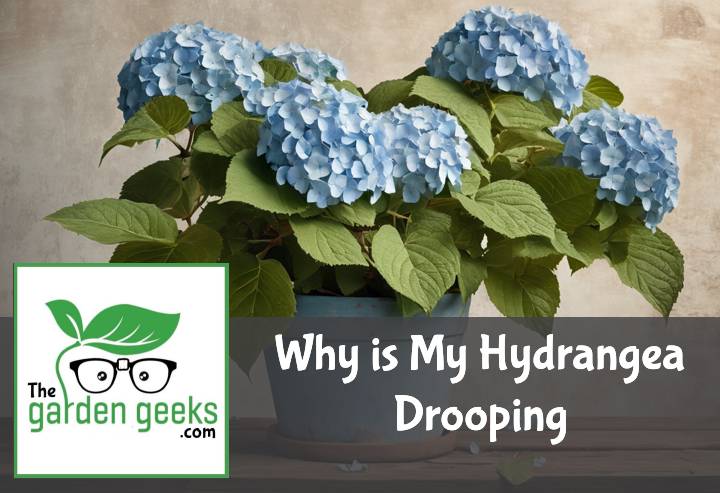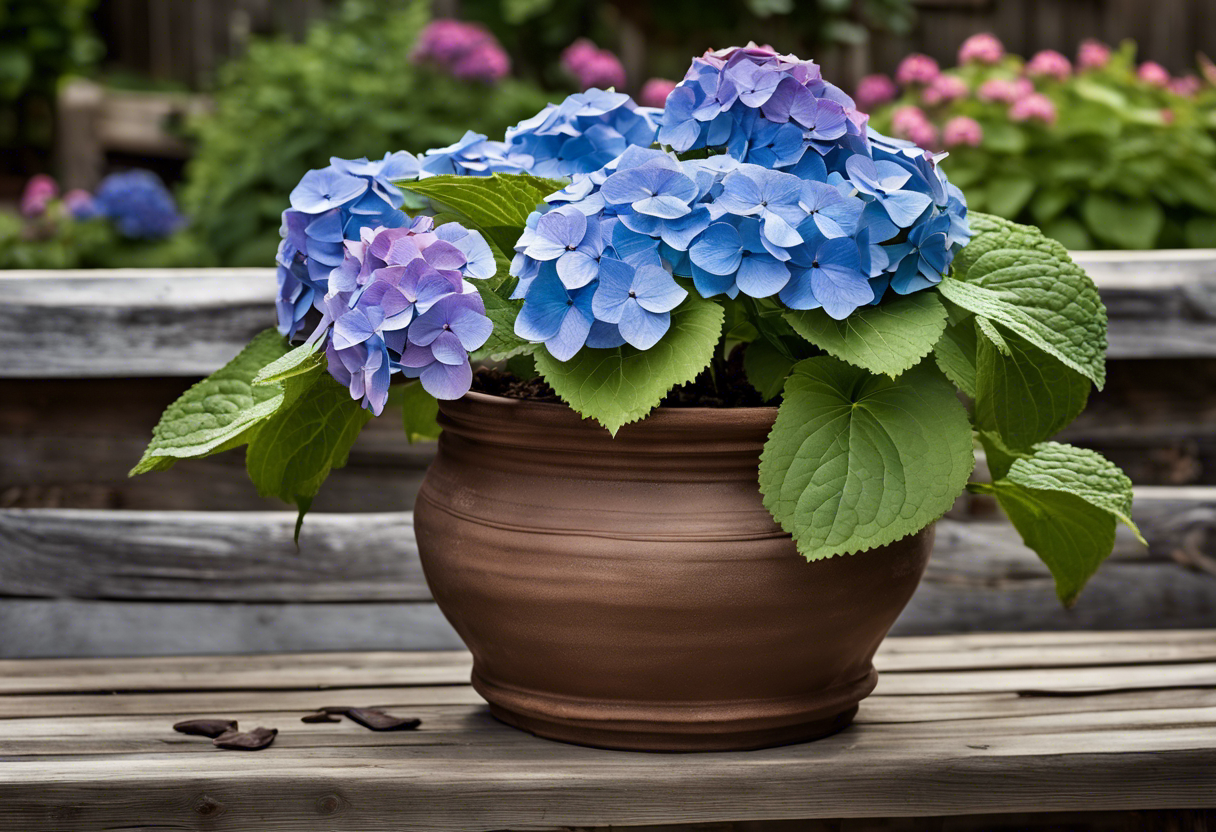Hello, fellow green thumbs! Ever looked at your garden and thought, Why is My Hydrangea Drooping? Well, you’re not alone. I once found myself in a similar pickle, staring at my wilting hydrangea with confusion and a dash of despair.
But don’t worry! This post is all about understanding the ups and downs (quite literally) of hydrangea health. So, buckle up for a ride into the world of droopy hydrangeas and how to bring them back to blooming life. Keep reading about ‘Why is My Hydrangea Drooping? (How to Save it)’!
Key Takeaways
- Hydrangeas droop due to overwatering, underwatering, too much sun, or a lack of nutrients.
- Overwatered hydrangeas have yellow leaves and soft stems, while underwatered ones have dry, brown leaves.
- Hydrangeas need morning sun and afternoon shade. Too much sun can cause wilting.
- Nutrient deficiency can be fixed by adding compost or a slow-release fertilizer.
- To save a drooping hydrangea, adjust watering habits, relocate if it’s getting too much sun, and add necessary nutrients.
Understanding Hydrangea Health
Hydrangeas are like the divas of the garden world. They’re stunning, but boy, do they have their needs! Maintaining hydrangea health can be a bit of a juggling act, dealing with hydrangea problems and catering to their specific requirements.
Identifying Healthy Hydrangea Characteristics
A healthy hydrangea is a sight to behold. Picture this: leaves greener than a leprechaun’s hat, blooms bigger than your head, and a plant so vigorous it could outgrow your nosy neighbor’s hedge. These are the telltale signs of healthy hydrangea traits. If your plant has vibrant leaves and abundant blooms, you’re doing something right!
Recognizing Signs of a Drooping Hydrangea
Now let’s talk about when things go south. You might ask yourself “Why is My Hydrangea Drooping?“. Well, drooping or wilting hydrangeas can be due to several reasons – overwatering (yes, there is such thing as too much love!) or disease. If your hydrangeas start looking more like wilted lettuce than the belle of the ball, it’s time to play plant detective and figure out what’s going wrong.
Common Causes for Hydrangea Drooping
Ever asked yourself, “Why is My Hydrangea Drooping?” Well, it’s usually due to a few common hydrangea care mistakes. Let’s dive into these drooping hydrangea causes and find some wilting hydrangea solutions.
Inadequate Watering
Hydrangeas are thirsty plants. If they’re not getting enough water, they’ll start to droop in protest. This is one of the classic under-watering symptoms in hydrangeas.
But don’t worry! Proper hydration for hydrangeas isn’t rocket science. It’s all about consistency and paying attention to your plant’s needs.
Remember, the effects of water stress on hydrangeas can be severe, so keep that watering can handy!
Over-Fertilization
Just like us after a big meal, hydrangeas can get a bit sluggish if they’ve been over-fertilized. The effects of over-fertilizing on hydrangeas include yellow leaves and – you guessed it – drooping.
Signs of fertilizer burn in hydrangeas can be pretty obvious, but sometimes we mistake them for other hydrangea problems.
The key here is balance: optimal fertilization for healthy hydrangreas doesn’t mean more is better!
Incorrect Sunlight Exposure
Hydrangeas love the sun, but too much of it can lead to a bad case of sunburn (yes, plants get sunburned too!). This is one reason why your hydrangea might be drooping.
Ideal sunlight for hydrangeas varies depending on the variety, but generally speaking, they prefer morning sun and afternoon shade.
So if your plant looks like it’s had too much sun (or not enough), adjusting its location could solve your drooping dilemma.
Disease and Pest Infestation
Finally, diseases and pests can also cause your hydrangea to droop. Common hydrangea diseases include leaf spot and powdery mildew, while aphids and scale insects are frequent culprits when it comes to pest infestation in hydrangeas.
Preventing disease in hydrangeas involves regular inspection, proper watering, and sometimes even a little bit of plant medicine (aka fungicides or insecticides).
So there you have it – the most common hydrangea issues that could be causing your plant’s droopy demeanor. Now go show that hydrangea some love!
How to Save Your Drooping Hydrangea
Alright, let’s talk about saving drooping hydrangeas. You’re probably wondering, “Why is My Hydrangea Drooping?“. Well, fear not! We’ve got some handy hydrangea care tips and hydrangea recovery methods that’ll get your plant back on its feet in no time.
Adjusting Watering Techniques
First things first, let’s look at your watering habits. Improper watering can lead to a sad, droopy hydrangea. Too much water? That’s a recipe for root rot. Too little? Your plant might just shrivel up and die.
So what are the proper hydrangea watering techniques? It’s all about balance. You want to give your hydrangeas enough water to keep them hydrated but not so much that they drown.
Modifying Fertilization Practices
Next up is fertilization. Just like us humans, plants need food too! But overdoing it with the fertilizer can do more harm than good.
The key is to find the right balance of nutrients for your hydrangeas. This means using the best fertilizer for hydrangeas, and applying it correctly. Over-fertilizing can burn the roots while under-fertilizing can leave your plant malnourished.
Altering Sunlight Exposure
Now let’s talk sunlight exposure. Hydrangeas love the sun but too much of it can cause them to wilt and droop.
On the other hand, too little sun will make them weak and pale. So finding the ideal light conditions for healthy hydrangeas is crucial in preventing them from drooping.
Treating Diseases and Pests
Last but not least, we have diseases and pests – every gardener’s worst nightmare! These buggers can wreak havoc on your beautiful hydrangeas.
Common culprits include powdery mildew, leaf spot diseases, and aphids. But don’t worry! With the right pest control for hydrangeas and disease prevention methods, you can keep your plants healthy and thriving.
Preventive Measures for Future Health of Your Hydrangea
When it comes to hydrangea care, the old saying “an ounce of prevention is worth a pound of cure” rings true. By focusing on preventive measures and plant health, you can keep your hydrangeas from drooping and ensure they stay healthy and vibrant.
Proper Planting Techniques
Let’s start with the basics, shall we? Proper hydrangea planting techniques are crucial. It’s not just about digging a hole and plopping in the plant. Nope, there’s more to it than that.
Firstly, make sure you’re planting at the right depth. Hydrangeas prefer their roots cozy but not smothered. Too deep or too shallow, and you might find yourself asking “Why is My Hydrangea Drooping?”
Secondly, consider the location. These plants love morning sun but appreciate some afternoon shade too. So pick a spot that offers this balance.
Lastly, don’t forget about soil quality! Rich, well-draining soil is what your hydrangeas crave for optimal plant health.
Regular Maintenance and Care
Now onto regular maintenance – another key player in preventing droopy hydrangeas. It’s like taking your car for regular oil changes; it keeps things running smoothly!
Watering is essential in hydrangea maintenance. These thirsty plants need plenty of water, especially during dry spells. But remember – overwatering can lead to root rot which can cause drooping too.
Pruning is another part of regular plant care that shouldn’t be overlooked. Prune your hydrangeas annually to promote new growth and prevent overcrowding.
Finally, don’t skimp on feeding your hydrangeas! A slow-release fertilizer applied in spring will keep them happy and healthy all season long.
To Wrap Up
Just like a toddler with a sugar rush, your hydrangea needs the right balance to thrive. Too much or too little of anything – water, sunlight, soil pH – can lead to the droopy blues. So don’t be shy about playing plant doctor!
For more on Why is My Hydrangea Drooping, hit that link! Remember, every green thumb starts with a little dirt under the nails.





